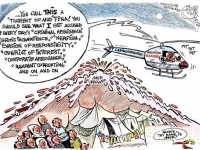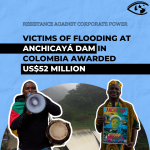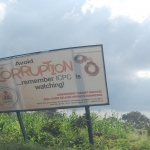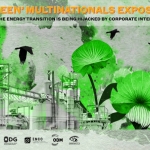Mud and the Minister: A Tale of Woe in Java

It was midnight when the earth exploded in Sidoardjo in East Java, Indonesia, sending a torrent of burning hot mud pouring from the earth's inner depths. Fadjariawan and Ibu Aisyah Sukantowere were in bed when a dull rumbling noise awoke them. The 35-year-old taxi driver and his wife took little notice at first since the area's many active volcanoes are prone to ominous noises. But when their neighbors came screaming to their doorstep, they joined the panicked flight to safer ground, grabbing only their 8-year-old daughter Afira and a few possessions.
They were lucky to have escaped what turned out to be a man-made rather than a natural disaster.
The May 29, 2006 blowout of the volcano Lusi (short for Lumpur Sidoardjo) unleashed more than 1 million cubic meters of liquid mud that inundated four villages, killing almost 100 people, and sending almost 12,000 villagers for medical treatment, some for burns, and many more from the toxic effects of hydrogen sulfide gas. The river of mud destroyed lives and livelihoods, permanently displacing at least 11,000 people and closing schools, factories, mosques, churches, and many shops in the area. The subsequent explosion of a gas pipeline that collapsed under the pressure from the mud stream killed 11 more victims.
"Now we sit here," said Fadjariawan from the makeshift tent in which his family lives. "We are trying to get in touch with the government and with the company. With anybody that might help to get us out of this situation, for it looks like we live in hell."
He believes that he has no more influence with the bureaucrats, politicians and executives who have the power to salvage his family than he did with the rushing mud that savaged their lives.
Indonesia's minister for social welfare at the time, Aburizal Bakrie, first said the volcano was a "natural disaster" caused by a small earthquake that had shaken the area a few days before the mud blowout. But Bakrie, whose family firm controls the oil and gas company PT Lapindo Brantas, had reason to cling to this explanation. His company had been drilling for gas in the area of the blowout.
Company Disappears
At the time of the blowout, PT Lapindo-Brantas was a subsidiary of PT Energi Mega Persada, or EMP, part of the Bakrie Group and the holding company of PT Lapindo-Brantas. EMP owns a 50 percent share, Medco Energi International has 32 percent, and Santos has 18 percent.
A month after the disaster, and following a visit from Indonesia's vice president, Jusuf Kalla, Bakrie accepted some responsibility on behalf of Lapindo, after the vice president and Energy and Natural Resources Minister Punomo Yusgiantoro criticized the company for incompetence in its handling of the Sidoardjo distaster. In November Lapindo agreed to pay $106 million toward the clean up.
But Lusi's cost to the economy, the environment and the populace is mounting as scientists and engineers have failed to staunch the small volcano that sits 30 miles south of Surabaya, the second largest city in Indonesia, with over two million inhabitants.
Faced with clear evidence that it was responsible, and escalating liabilities, Lapindo took another track.
Four months after Lusi blew, PT Lapindo-Brantas ceased to exist. It was sold for $2 to Lyte Limited, registered on the offshore island of Jersey. Lyte is solely owned by the Bakrie Group and was soon renamed Bakrie Oil & Gas. According to the New York Times, "Energi Mega Persada, had said in an official securities filing that it was selling Lapindo because of the huge costs it faced in cleaning up after the mud flow, and it was better to use its assets for its other oil and gas projects."
Some now fear that the company Bakrie Oil & Gas will go bankrupt, making environmental restoration and compensation to the victims impossible, as the rest of the Bakrie empire has been careful to remain legally separate. Asked by Tempo magazine in October 2006 if "the Lapindo mud problem [is] affecting the Bakrie businesses," Anindya Bakrie, the oldest son of the minister, a 32-year-old Stanford MBA graduate, answered ambiguously, "Thankfully, no. Yet we are responsible for all that has happened. However, the other Bakrie companies should not be held responsible for the Lapindo problem."
When questioned directly if the eruption was Lapindo's fault, Bakrie hedged: "Lapindo is a contractor, not the proprietor of the oil and gas field. The contractor is tied to a revenue-sharing agreement with the government. So, if we incur losses, should Lapindo be the only one to bear the burden? We want some clarification. Otherwise, should Bakrie Telecom build a tower at volcanic Mount Merapi and it erupts, it will be responsible [for the catastrophe]."
Government Ties Helped Weather Previous Crisis
Shifting responsibility to the government is an interesting tactic, given that the two biggest shareholders in Lapindo -- Bakrie and Medco -- have senior political positions. This intertwining of business and politics is a common feature of Indonesian life. Aburizal Bakrie, the minister, shares ownership of the Bakrie Group with his younger brothers. He served as company chief executive until he became the country's chief economic minister in 2004. After a cabinet reshuffle in 2005, he was appointed coordinating minister for People's Welfare.
Medco Energi, the second biggest shareholder in Lapindo, was founded in 1994 by Arifin Panigoro, one of Indonesia's 40 richest men, with a net worth of $815 million. The Medco website lists him as "successively, a legislator, a Presidential Advisor to the National Business Development Council and deputy chairman of the Executive Board of the Indonesian Democratic Party of Struggle (PDIP)." Medco Group is currently headed by Arfin's brother, Himli Panigoro, a trained geologist.
Although the businesses suffered serious financial setbacks during the Asian economic crisis of the 1990s, a restructured management, capital and share ownership, and a close friendship with the Suharto family have helped it make a comeback.
Since then, Lapindo has become active in agriculture, real estate, trade, shipping, banking, construction, insurance, manufacturing, media and mining. Their current holdings include the PT Bakrie plantations, Bakrie Kaisei, Bakrie Electronics, the Bali Nirwana Resort, and a 20 percent share in Arutmin coal in East Kalimantan.
Its telecommunications venture is developing Indonesia's cellular service, offering cut-price rates all over the archipelago, to a promising market of 16,000 islands with 200 million inhabitants. It is also active in another mega-project, a $1.2 billion gas pipeline from East Kalimantan to Central Java.
After the Lusi disaster the group is trying to project a new image, focusing on its core business, and attempting to lure overseas rather than local investors. "The family now puts themselves at the same level as other investors, it's just that they have more shares in each Bakrie company," a company spokesperson says.
Scientists Weigh In
While the Bakrie family distances itself financially and legally from Lapindo, scientists hold the drilling company responsible for the blowout.
"The (drilling) well had reached a depth of over 3,000 meters when three different mud flows started," a United Nations report concluded. "The first and largest flow started on 29 May 2006 and is situated at 200 meters southwest of the drilling well." Within a few days two smaller flows erupted but were stopped, but the larger one continued.
The flow now averages between "7,000 and 150,000 cubic meters (245,000 and 5.25 million cubic feet, respectively) of mud every day and ... will continue for many months and possibly years to come," a report published in the magazine of the Geological Society of America, GSA Today concluded.
After studying the area on the ground and through satellite imagery, scientific and engineering studies ruled out the earthquake as the cause of the disaster. The GSA Today, and U.N. reports, as well as an investigation by British scientists, all lay the blame fully and squarely on Lapindo, Bakrie's company.
They concluded that the blowout of the mud volcano was not so much an accident as the predictable result of incompetence, negligence, or both. British scientists cited in New Scientist magazine called the seepage of mud and water a preventable hazard.
Since it is not unusual for mud volcanoes to result from drilling operations, international companies warned Lapindo years ago to take extra care when drilling in the geologically unstable region. According to Dr. Eddy Soedjono and Dr. Agnes Tuti, researchers at the nearby Surabaya University, the company could have averted the disaster by protecting the drilling hole with a steel casing.
British scientist Richard Davies agrees: "It is standard industry procedure that this kind of drilling requires the use of steel casing to support the borehole and protect against the pressure of fluids such as water, oil or gas," he told New Scientist.
"[Lapindo] ignored the warnings," said Soedjono. "The company was fined $360 million by the government, but appealed as they deny their responsibility, arguing that since it is a natural disaster and not man-made, the government, not the company should take care of the victims. While the quarreling is continuing the people suffer."
The toxic mud from the drilling blowout is devastating agriculture and fishing industries and polluting the environment with increased salinity and mercury. A layer of mud, rising 20 meters high in the worst hit places and covering rooftops, is growing daily around the center mouth of the eruption. Researchers fear that much of the 25 square mile area around the current mud-pool will ultimately collapse.
Clean Up and Compensation
Today, both the government and the company have been ineffective in either helping victims or dealing with the mud flow -- despite the efforts of a presidential and national disaster relief team from Jakarta that has taken over most rooms at Surabaya's luxurious Hotel Somerset.
Government efforts to divert or bottle up the mudflow have failed. In February and March, engineers dropped around 800 half-ton-each concrete balls linked to steel cables into the mouth of the eruption. The plan failed twice, as did the construction of emergency embankments and dykes that the mud soon breached, burying more homes.
In May, near the one-year anniversary of the disaster, Indonesian and Japanese engineers pitched an ambitious plan to President Susilo Bambang Yudhoyono to build a 15-story-high concrete dam around the mud volcano at a cost of $70 million.
Another scheme underway is using heavy equipment to divert the mud into pipes that eventually expel it into the Porong River seven miles away. Engineers had hoped the river would be strong enough to transport the mud to the Java Sea 50 miles upstream. But hundreds of dead fish are turning up in the river and fishermen are claiming that their livelihoods are threatened.
The Bakrie Group has announced that it will not cancel the Lusi project, but will probably support local philanthropy through a foundation modeled on those formed in the United States by the Ford, Gates and Rockefeller families, where the company management is legally distinct from the foundation trustees.
Meanwhile various government, corporate and citizen groups have tossed out figures about how much compensation should be paid and to whom, and how that compares to what has actually been handed out. In December 2006, Yudhoyono ordered Lapindo to pay 3.8 trillion rupiah ($421 million) in compensation and costs related to the mudflow. Some officials estimate that the costs could be double that amount. But Yudhoyono did not say whether Australia-based Santos and Medco Energi would have to share the burden.
According to an October 2006 Jakarta Post article: "All of the costs will reportedly be borne by Lapindo, whose general manager, Imam Agustino, said the company would allocate US$140 million to cover all expenses. Lapindo claims to have already spent $70 million as of mid-September on operational costs and in compensation to victims. Each affected family receives Rp 300,000 ($30) in monthly meal allowances and Rp 2 million ($221) to rent a house for two years. It remains unclear how Lapindo determined the amount of the payments, or if it will offer more money in the future to help the families restart their lives."
Lapindo says it is only partially responsible, should not have to cover the full costs, and insists that it has paid out some $300,000 for lost homes. But many locals say they have received nothing but a distribution of three meals a day, which invariably consists of nasi goreng -- fried rice -- with fish or chicken and vegetables.
"We are not beggars, we just ask for our rights," Sudarto, a refugee living in a Porong market, told AFP, reacting to a company offer to pay some victims 20 percent of the value of their home and lands. Sudarto and the other 3,200 victims in Porong want Lapindo to buy their land so they can rebuild elsewhere.
As fresh hot mud spreads daily, the number of volcano refugees mounts, with many forced to live in homemade tents or in refugee camps set up in covered markets. When a similar levee broke recently at Besuki, a small town with 5,000 inhabitants, the houses filled slowly but surely with unstoppable mud.
Protests Ignored
Back at Fadjariawan's tent, a continuously shifting cast of strangers and friends drops in to discuss the situation. Some prepare for a hastily organized mass demonstration in Surabaya, the district capital. They will go there on their motorbikes to ask relief from their desperate living conditions and try to pressure the local government, the company and central authorities in Jakarta to do the right thing.
From time to time groups of angry, desperate residents visit the offices of Lapindo that lie abandoned halfway between Surabaya and Sidoardjo. Security guards stand vigil over the empty building as protesters demand satisfaction, answers, compensation. A meal is not enough -- what about homes, jobs, schools, churches, ask some. "What about our life? " requests one brochure published by the protestors. Why, ask some protestors, doesn't Lapindo take full responsibility?
Recently, the company tried to placate the continuous protests by ordering their spokesperson, Asip, to distribute a brochure highlighting the lighter side of mudflows. The brochure compares Lusi to a sexy and very well-dressed young woman: fun to watch and talk to. It also informs the public that mud volcanoes are all over the world, even in the U.S., and geologists have fascinating stories to tell about them.
There is also a photo display showing enthusiastic tourists viewing the disaster. The headline says: "When the mud lake becomes an attraction."
Victims can also watch a 13-episode soap opera on local television financed by Lapindo. It is the love story about a young man and a woman on the run for the mudflow who fall in love. Awi Setiawan, the director, describes it as a real human-interest story that will grab the audience "by the balls."
Future Looks Muddy
Today, Fadjariawan, Ibu Aisyah Sukanto, and eight-year-old Afira live under a blue plastic tarpaulin, pitched between railroad tracks and a highway. It is furnished with a few mattresses, a fan, a television, and some small pots and pans. The family motorbike sits out front not far from the gutter from which they draw water for washing the clothes drying in the hot air.
Fadjariawan says that the fried rice from Lapindo is not even sufficient nutrition. Some people are showing symptoms including hair loss and skin rashes that could be caused by malnourishment or the lingering effects of the poisonous hydrosulfide released with the mud stream. The effects of the low levels of mercury released have yet to be assessed.
Exhaling fragrant smoke from clove-flavored kretek cigarettes, he recalls the blowout and counts himself and his family as lucky to have survived. One family he knows did not react quickly enough. Their daughter is now in a hospital with severe burns. "Fresh mud is temperature hot," he says, "and is able to cause some nasty burns." Experts put the surface temperature at more than 200 degrees Fahrenheit.
It takes about ten minutes to travel by motorbike to where the town center and Fadjariawan's house once stood. Surveying the devastation, his eyes fill with tears he does not wipe away; his voice is thick with emotion. The stench of rotten gas is almost unbearable.
"Please go tell [Lapindo] we want cash and carry," he tells this reporter. "You go tell them. Maybe they'll listen to you. Please. Please."
This article was made possible by a generous grant from the Hurd Foundation.
- 106 Money & Politics
- 116 Human Rights
- 182 Health
- 183 Environment
- 185 Corruption
- 190 Natural Resources



